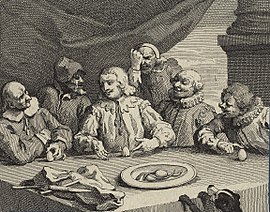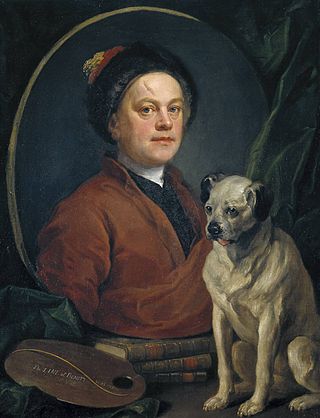
William Hogarth was an English painter, engraver, pictorial satirist, social critic, editorial cartoonist and occasional writer on art. His work ranges from realistic portraiture to comic strip-like series of pictures called "modern moral subjects", and he is perhaps best known for his series A Harlot's Progress, A Rake's Progress and Marriage A-la-Mode. Familiarity with his work is so widespread that satirical political illustrations in this style are often referred to as "Hogarthian".
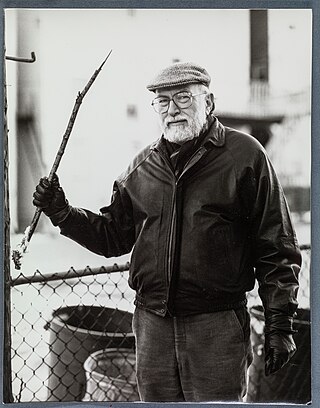
Ronald Howard Paulson was an American writer and professor of English who was a specialist in English 18th-century art and culture, and the world's leading expert on English artist William Hogarth.
A Rake's Progress is a series of eight paintings by 18th-century English artist William Hogarth. The canvases were produced in 1732–1734, then engraved in 1734 and published in print form in 1735. The series shows the decline and fall of Tom Rakewell, the spendthrift son and heir of a rich merchant, who comes to London, wastes all his money on luxurious living, prostitution and gambling, and as a consequence is imprisoned in the Fleet Prison and ultimately Bethlem Hospital (Bedlam). The original paintings are in the collection of Sir John Soane's Museum in London, where they are normally on display for a short period each day.
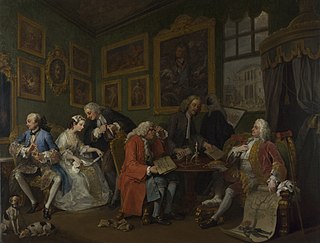
Marriage A-la-Mode is a series of six pictures painted by William Hogarth between 1743 and 1745, intended as a pointed skewering of 18th-century society. They show the disastrous results of an ill-considered marriage for money or social status, and satirize patronage and aesthetics. The pictures are held in the National Gallery in London.
A Harlot's Progress is a series of six paintings and engravings (1732) by the English artist William Hogarth. The series shows the story of a young woman, M. Hackabout, who arrives in London from the country and becomes a prostitute. The series was developed from the third image. After painting a prostitute in her boudoir in a garret on Drury Lane, Hogarth struck upon the idea of creating scenes from her earlier and later life. The title and allegory are reminiscent of John Bunyan's Pilgrim's Progress.
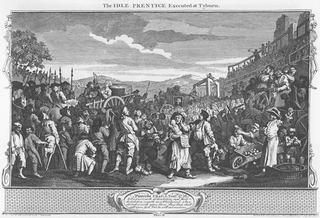
Industry and Idleness is the title of a series of 12 plot-linked engravings created by the English artist William Hogarth in 1747, intending to illustrate to working children the possible rewards of hard work and diligent application and the sure disasters attending a lack of both. Unlike his earlier works, such as A Harlot's Progress (1731) and Marriage à-la-mode (1743), which were painted first and subsequently converted to engravings, Industry and Idleness was created solely as a set of engravings. Each of the prints was sold for one shilling each so 12 shillings for the entire set, which is equivalent to £120 in 2023. It may be assumed that these prints were aimed for a wider and less wealthy market than his earlier works. The originals currently reside at the British Museum.

The Four Stages of Cruelty is a series of four printed engravings published by English artist William Hogarth in 1751. Each print depicts a different stage in the life of the fictional Tom Nero.

Four Times of the Day is a series of four oil paintings by English artist William Hogarth. They were completed in 1736 and in 1738 were reproduced and published as a series of four engravings. They are humorous depictions of life in the streets of London, the vagaries of fashion, and the interactions between the rich and poor. Unlike many of Hogarth's other series, such as A Harlot's Progress, A Rake's Progress, Industry and Idleness, and The Four Stages of Cruelty, it does not depict the story of an individual, but instead focuses on the society of the city in a humorous manner. Hogarth does not offer a judgment on whether the rich or poor are more deserving of the viewer's sympathies. In each scene, while the upper and middle classes tend to provide the focus, there are fewer moral comparisons than seen in some of his other works. Their dimensions are about 74 cm (29 in) by 61 cm (24 in) each.

The Gate of Calais or O, the Roast Beef of Old England is a 1748 painting by William Hogarth, reproduced as a print from an engraving the next year. Hogarth produced the painting directly after his return from France, where he had been arrested as a spy while sketching in Calais. The scene depicts a side of beef being transported from the harbour to an English tavern in the port, while a group of undernourished, ragged French soldiers and a fat friar look on hungrily. Hogarth painted himself in the left corner with a "soldier's hand upon my shoulder."

Characters and Caricaturas is an engraving by English artist William Hogarth that he produced as the subscription ticket for his 1743 series of prints, Marriage à-la-mode, and which was eventually issued as a print in its own right. Critics had sometimes dismissed the exaggerated features of Hogarth's characters as caricature and, by way of an answer, he produced this picture filled with characterisations accompanied by a simple illustration of the difference between characterisation and caricature.

The Bench is the title of both a 1758 oil-on-canvas painting by the English artist William Hogarth, and a print issued by him in the same year. Unlike many of Hogarth's engravings produced from painted originals, the print differs considerably from the painting. It was intended as a demonstration of the differences between character painting, caricature and outré—developing on the theme he had begun to address in Characters and Caricaturas —but Hogarth was unhappy with the result as it showed only "characters", and he continued to work on the piece until his death.
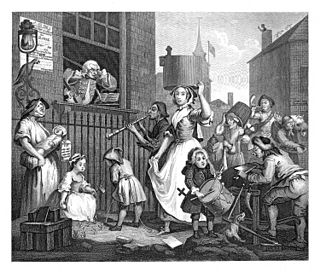
The Enraged Musician is a 1741 etching and engraving by English artist William Hogarth which depicts a comic scene of a violinist driven to distraction by the cacophony outside his window. It was issued as companion piece to the third state of his print of The Distrest Poet.

The Distrest Poet is an oil painting produced sometime around 1736 by the British artist William Hogarth. Reproduced as an etching and engraving, it was published in 1741 from a third state plate produced in 1740. The scene was probably inspired by Alexander Pope's satirical poem The Dunciad. It depicts a scene in a small, dingy attic room where a poet sits at his desk in the dormer and, scratching his head, stares at the papers on the desk before him, evidently looking for inspiration to complete the poem he is writing. Near him sits his wife darning clothes, surprised by the entrance of a milkmaid, who impatiently demands payment of debts.

Beer Street and Gin Lane are two prints issued in 1751 by English artist William Hogarth in support of what would become the Gin Act. Designed to be viewed alongside each other, they depict the evils of the consumption of gin as a contrast to the merits of drinking beer. At almost the same time and on the same subject, Hogarth's friend Henry Fielding published An Inquiry into the Late Increase in Robbers. Issued together with The Four Stages of Cruelty, the prints continued a movement started in Industry and Idleness, away from depicting the laughable foibles of fashionable society and towards a more cutting satire on the problems of poverty and crime.

The March of the Guards to Finchley, also known as The March to Finchley or The March of the Guards, is a 1750 oil-on-canvas painting by English artist William Hogarth, owned by and on display at the Foundling Museum. Hogarth was well known for his satirical works, and The March of the Guards to Finchley has been said to have given full scope to this sense of satire; it was described by Hogarth himself as "steeped in humour".

Emblematical Print on the South Sea Scheme is an early print by William Hogarth, created in 1721 and widely published from 1724. It caricatures the financial speculation, corruption and credulity that caused the South Sea Bubble in England in 1720–21. The print is often considered the first editorial cartoon or as a precursor of the form.

The Bad Taste of the Town is an early print by the British artist William Hogarth, first published in February 1723. The small print – 5 by 6 inches – mocks the contemporary fashion for foreign culture, including Palladian architecture, pantomimes based on the Italian commedia dell'arte, masquerades, and Italian opera. The work combines two printmaking techniques – etching and engraving – with etched lines made in the plate using acid and engraved lines marked using a burin.
Revd John Trusler (1735–1820) was an eccentric English divine, literary compiler, and medical empiric.

Jane Hogarth was a British printseller and businesswoman who preserved the rights to the artwork of her husband, William Hogarth, following his death. She successfully continued to produce and sell his work for many years.
